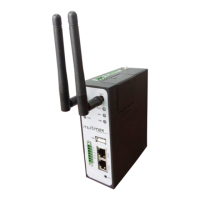Tick to enable NAT Traversal for OpenVPN. This item must be
enabled when router under NAT environment.
Set ping interval to check if the tunnel is active.
Restart to establish the OpenVPN tunnel if ping always timeout
during this time.
Select from “None” and ”LZO”, select “LZO” to use the LZO
compression library to compress the data stream.
Select from “BF-CBC”, “DES-CBC”, “DES-EDE3-CBC”,
“AES128-CBC”, “AES192-CBC” and “AES256-CBC”.
BF-CBC: Uses the BF algorithm in CBC mode and 128-bit key.
DES-CBC: Uses the DES algorithm in CBC mode and 64-bit key.
DES-EDE3-CBC: Uses the 3DES algorithm in CBC mode and
192-bit key.
AES128-CBC: Uses the AES algorithm in CBC mode and 128-bit
key.
AES192-CBC: Uses the AES algorithm in CBC mode and 192-bit
key.
AES256-CBC: Uses the AES algorithm in CBC mode and 256-bit
key.
Maximum Transmission Unit. It is the identifier of the maximum
size of packet, which is possible to transfer in a given
environment.
Set the Max Frame Size for transmission.
Select the log output level which from low to high: “ERR”,
“WARNING”, “NOTICE” and “DEBUG”. The higher level will
output more log information.
You can enter some other PPP initialization strings in this field.
Each string can be separated by a space.
Click “Add” to add a OpenVPN client info which include
“Common Name”, “Password”, “Client IP”, “Local Static
Route” and “Remote Static Route”. This field only can be
configure when you select “Username/Password”
in ”Authentication”.

